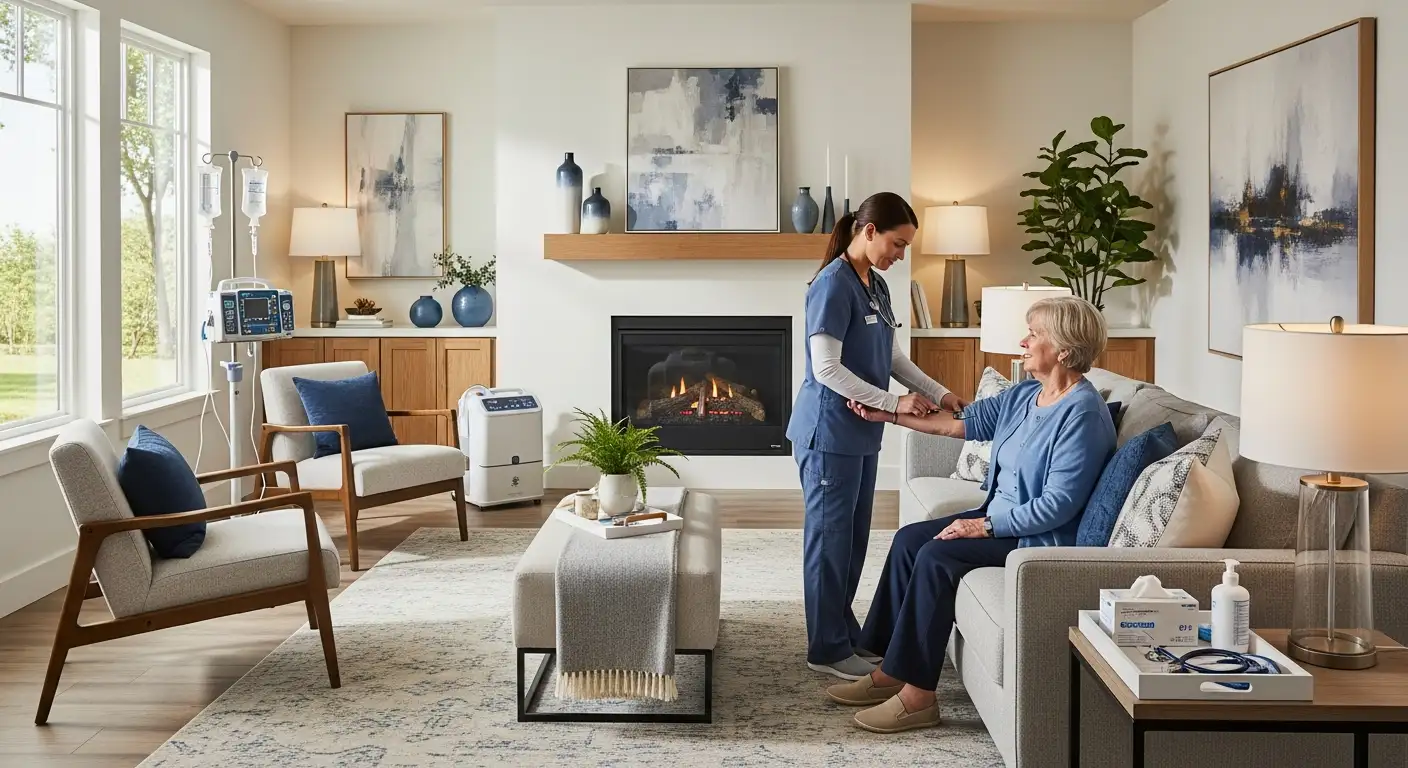Creating a Secure and Efficient Home Medication System for Seniors
Organizing a home medication station for seniors requires thoughtful planning to ensure safety, accessibility, and adherence. Proper management not only prevents errors and accidents but also promotes independence and peace of mind for families and caregivers. This article provides detailed guidance on establishing an effective medication organization system tailored specifically for seniors, drawing from trusted practices and innovative solutions.
Comprehensive Medication Inventory and Documentation

How should I conduct a complete inventory of medications in my home?
Start by checking all possible storage spaces such as drawers, cupboards, first aid kits, travel bags, and car kits. Carefully gather every bottle, box, and package. It’s important to be thorough to ensure no medication is overlooked.
What methods can I use to organize medication information effectively?
Creating a detailed documentation system is highly recommended. You can use a spreadsheet, a written list, or a digital app. This record should include medication names, dosages, prescription and purchase dates, prescribing doctors, expiration dates, and specific storage instructions. Keeping this information organized makes medication management clearer and safer.
What details should be included in the medication record?
Your medication list should cover:
- Name of the medication
- Dosage and administration instructions
- Purpose of the medication
- Prescribing physician
- Date it was prescribed or purchased
- Expiration date
- Special storage instructions, such as away from heat or humidity
- Potential side effects and interactions
- Refill information or schedule
This comprehensive approach helps prevent confusion and ensures proper medication adherence, especially for households managing multiple prescriptions.
Safe Disposal of Expired and Unused Medications
 Properly disposing of medications is an essential part of medication management to keep households safe and environmentally friendly. Medications should never be thrown in the trash or flushed down toilets, as these practices can harm ecosystems and pose risks if they fall into the wrong hands.
Properly disposing of medications is an essential part of medication management to keep households safe and environmentally friendly. Medications should never be thrown in the trash or flushed down toilets, as these practices can harm ecosystems and pose risks if they fall into the wrong hands.
One recommended approach is to use authorized collection sites or medication take-back programs. Many pharmacies and communities offer this service, allowing residents to drop off unused or expired medicines securely and anonymously. For example, Klingensmith’s Drug Store provides a free, no-questions-asked medication disposal program at all its locations, making it easy and safe for customers to dispose of medicines responsibly.
When home disposal is necessary, it is advisable to mix unused medications with undesirable substances like used coffee grounds, cat litter, or dirt. This mixture should then be placed in a sealed bag to prevent tampering or accidental ingestion. It’s also important to remove any personal identifiers from prescription bottles to protect privacy.
By following these methods, households can prevent medication misuse, accidental poisoning, or environmental contamination. Regularly reviewing and clearing out expired or unused medicines helps maintain a safe storage environment and ensures medicines remain effective.
Important safety considerations for medication storage for seniors include:
- Keeping medicines out of reach of children and pets.
- Storing medications in a cool, dry place, away from heat, moisture, and sunlight.
- Using childproof and senior-friendly containers.
- Organizing medications with clear documentation for easy access.
- Having regular medication reviews with healthcare professionals.
Adopting these practices supports the safety and well-being of seniors and all household members, reducing risks related to medication errors or accidental ingestion.
Optimizing Storage for Accessibility and Safety
How can medication storage be optimized for accessibility and efficiency?
Creating a well-organized medication storage system is essential for safety and ease of use, especially in homes with multiple family members or seniors. The first step is selecting containers that are clear, labeled, and easy to open. Using containers with contrasting colors or large print labels helps those with visual impairments quickly identify their medicines.
Designating a central, accessible spot—such as a kitchen cabinet, drawer, or linen closet—ensures medications are within reach when needed. Storing medicines away from heat sources, humidity, and sunlight, like in a small medicine refrigerator or a dry, dark cabinet, helps maintain their effectiveness.
Implementing organizational tools can significantly improve medication management. Pill organizers or pillboxes grouped by days or times help prevent missed doses. Color coding bottles or labels further streamlines identification. Lockable storage cabinets add a safety layer for households with children.
Reminder systems like phone alarms, automatic dispensers, or smart pillboxes that beep or send alerts can prompt timely medication intake. Maintaining an up-to-date medication list, along with each medication's details such as dosage, purpose, and expiration date, reduces errors.
Regular review of stored medications, with disposal of expired drugs—preferably through authorized collection sites—ensures the system remains safe. Engaging healthcare providers or caregivers in managing medications supports adherence and safety tailored to individual needs.
By combining these strategies—organized containers, clear labeling, accessible placement, safety features, and reminder tools—homes can be optimized for safe, efficient, and accessible medication management.
Categorizing and Grouping Medications for Ease of Use

What methods can be used to categorize and group medications for easier access?
Organizing medications systematically is crucial for safety and efficiency. One effective approach is to separate medicines into specific categories like pain relief, vitamins, first aid supplies, allergy medications, and prescriptions. Assigning each category a dedicated storage space, such as labeled drawers, bins, or containers, makes locating items faster.
Color-coding is a simple yet powerful visual aid. For example, red for first aid, blue for vitamins, and yellow for pain relief, helps quickly identify categories, especially in emergencies. Labels with clear wording or tactile identifiers like braille can further improve accessibility.
Using organizational tools such as pill organizers or electronic dispensers also enhances daily management, helping with scheduled doses and reminding users when medications are due. Placing all medications out of reach of children and pets adds safety, while consolidating inventory prevents missed doses or expired medicines.
Regular assessment for expiration dates and sorting medications into a central, secure location keeps the storage efficient. Developing a structured plan tailored to your household’s needs, such as a color-coded system or designated shelves, makes medication management more straightforward.
Summary of Categorization Strategies:
| Method | Description | Benefits |
|---|---|---|
| Category Sorting | Separate medications into groups like pain relief, vitamins, first aid | Easy to locate and replenish |
| Color-Coding | Use colored labels or containers for each category | Visual quick-reference |
| Labeling | Clear labels with text or tactile symbols | Improves accessibility |
| Organizational Tools | Pill organizers, electronic dispensers | Ensures correct doses and times |
| Safety Placement | Store out of children’s reach | Prevents accidental ingestion |
| Regular Review | Check expiration dates and consolidate | Keeps inventory accurate |
Implementing these methods can streamline medication management, foster safety, and reduce stress during daily routines.
DIY Storage Solutions and Organizational Tools
Managing medications at home can be simplified with practical, do-it-yourself (DIY) storage solutions and organizational tools. These approaches not only keep medications accessible and organized but also enhance safety, especially for seniors and households with multiple members.
One effective method is repurposing household containers such as small jars, mugs, or plastic containers. These can be used to group similar medications or supplements, making them easy to locate and less likely to be misplaced.
Labeled storage bins and drawer dividers are invaluable in categorizing medicines by type, usage frequency, or person. Clear plastic bins with labels allow for quick identification, while drawer dividers help separate different medications within drawers, preventing mix-ups.
Space-saving tools maximize limited storage areas. Lazy Susans can be placed on shelves or inside cabinets to spin and access medications without clutter. Mounting spice racks on the insides of cabinet doors provides additional space for small bottles and pillboxes. Over-the-door organizers with pockets or hooks create accessible compartments, making frequently used medications easy to grab.
Labels play a crucial role in medication management. Using waterproof labels with clear writing ensures that each container’s contents, expiration date, and dosage instructions are visible. Regularly checking these labels helps prevent the use of expired medicines.
For daily routines, portable tubs or baskets categorized by person or medication type enable transportation within the home or while traveling. This ensures medications are taken correctly and safely.
In summary, integrating these DIY storage solutions—such as repurposed household containers, labeled bins, space-efficient organizers, and portable baskets—can significantly improve medication safety and organization. They are cost-effective, customizable, and adaptable to various home layouts, supporting an organized and safe medication management system.
Creating a User-Friendly Medication System
 Establishing a medication management system that is both safe and easy to use is especially important for seniors living at home. Combining physical tools, digital alerts, and routine organization strategies can significantly improve safety and adherence.
Establishing a medication management system that is both safe and easy to use is especially important for seniors living at home. Combining physical tools, digital alerts, and routine organization strategies can significantly improve safety and adherence.
First, utilizing physical tools such as clearly labeled, large-print medication containers or pill organizers makes it easier for seniors to identify and access their medications. Lockable cabinets or secure storage places help keep medicines out of children’s reach, adding a layer of safety.
Next, linking medication doses to daily routines is effective. For example, placing medications near the kitchen sink or bedside table, and using automatic dispensers with alarms or smartphone reminders, creates consistent habits that reduce missed doses.
Maintaining a detailed list of all medicines is crucial. This list should include medication names, dosages, prescribed times, prescribing doctors, and expiration dates. Keeping this updated ensures clarity and assists healthcare providers during checkups or emergencies.
Regular medication reviews with healthcare professionals are necessary to ensure the current prescriptions remain appropriate. Reviewing medications for potential interactions and side effects, and simplifying regimens whenever possible, helps avoid confusion and adverse effects.
Pharmacy services can be advantageous, such as blister packaging, automatic refills, and free home delivery. These offerings reduce errors, streamline medication management, and support independence.
Overall, creating a comprehensive medication system involves combining physical tools like organized pillboxes with digital aids, linking medications to daily routines, keeping detailed records, and scheduling frequent reviews. This structured approach fosters a safer environment, promotes adherence, and supports aging in place with confidence.
Choosing Suitable Pill Organizers and Storage Containers
 When managing medications at home, selecting the right pill organizers and storage containers is essential for safety and convenience, especially for seniors. There are various options designed to suit different needs and lifestyles.
When managing medications at home, selecting the right pill organizers and storage containers is essential for safety and convenience, especially for seniors. There are various options designed to suit different needs and lifestyles.
For daily, weekly, and monthly medication routines, dispensers with multiple compartments can help organize pills over different periods. These are especially useful for reducing missed doses and simplifying complex medication schedules.
Large, easy-open containers are highly recommended for seniors or those with limited dexterity. These containers should feature simple lids that are easy to grasp and open, even for individuals with arthritis or reduced hand strength. Clear labels with high-contrast text or tactile features like raised symbols improve identification and usability.
Organizers equipped with reminders or alarms can further support adherence. Some models include audible alerts or vibrating alarms to signal when it's time to take medication, which is beneficial for people with memory issues or multi-dose regimens.
In addition to pill dispensers, durable storage containers that are moisture-proof and impact-resistant protect medications from environmental factors like humidity, heat, and light. These containers can store bulk medication supplies or additional pillboxes.
Proper labeling—using large, legible fonts—helps prevent mistakes, especially for those with vision impairments. Combining labeled containers with distinct colors or tactile cues can make medication management safer and more intuitive.
Overall, choosing the right tools can significantly improve medication adherence, reduce errors, and promote safety in the home environment.
| Type of Organizer | Suitable For | Features | Benefits |
|---|---|---|---|
| Daily/Weekly/Monthly Dispensers | Seniors, busy households | Multiple compartments, easy-open lids | Simplifies schedule, reduces missed doses |
| Large, Clear Containers | All users, especially with dexterity challenges | Easy-to-open, labeled, high-contrast | Enhances safety, speed, and identification |
| Organizer with Reminders/Alarms | Memory-impaired users | Built-in alarms, vibrating alerts | Promotes timely medication intake |
| Moisture-proof Storage | Bulk storage needs | Sealed, impact-resistant | Preserves medication integrity |
Proper storage and organization of medications contribute significantly to safety and efficiency. Tailoring these tools to individual needs ensures optimal medication management and peace of mind.
Enhancing Medication Adherence through Organized Setups
How can organized medication setup improve adherence and management for seniors?
Implementing a well-structured medication setup can greatly boost adherence among seniors who often face challenges with complex medication schedules. Simplifying regimens, such as switching to once-daily dosing instead of multiple doses, makes it easier for seniors to follow their treatment plans.
Using visual cues and adherence packaging, such as color-coded bottles and clearly labeled containers, helps seniors easily identify and remember their medications. Large-print labels, pill organizers, and easy-to-read instructions can improve safety and reduce errors.
Technological aids like electronic dispensers or automatic medication reminders provide timely alerts, ensuring medications are taken as prescribed. Homes equipped with these devices can support independence and reduce the risk of missed doses.
Healthcare providers and pharmacists play a critical role by offering personalized guidance, reviewing medication regimens regularly, and addressing potential barriers such as side effects or cost.
In addition, creating a supportive environment with frequent communication and education about medication purposes and importance encourages consistent use. This comprehensive approach, combining simplicity, visual aids, technology, and professional support, enhances medication management and health outcomes for seniors.
Building a Safe and Organized Medication Routine
Implementing these meticulous organizational strategies transforms medication management into a safe, efficient, and user-friendly process for seniors. Regular reviews, proper disposal, accessible storage, and technological support collectively enhance safety, foster independence, and improve adherence. A well-structured medication station not only reduces errors and accidents but also provides peace of mind for caregivers and families, ensuring that seniors maintain their health and well-being effectively.
References
- Medication Management: Out with the Old, In with Organization
- The Best Way to Organize Medicine in Your Home
- How to Organize Medicine - SeniorAdvisor.com Blog
- Tips for Organizing Your Medications | Burlington Pharmacy
- How to Organize Your Medicine Cabinet | The Healthy
- Medication Management at Home: Tips for Seniors and Caregivers
- Managing medications for aging parents - Mayo Clinic Health System
- How to Organize Medications: Essential Tips for Seniors and ...
- Medication Management Tips for Seniors | Valleywise Health
- A Caregiver's Guide to Medication Management



